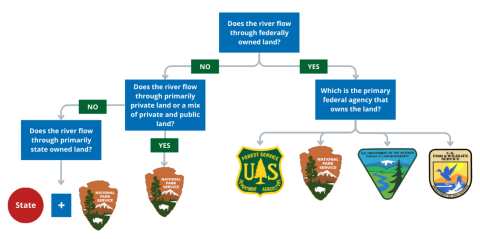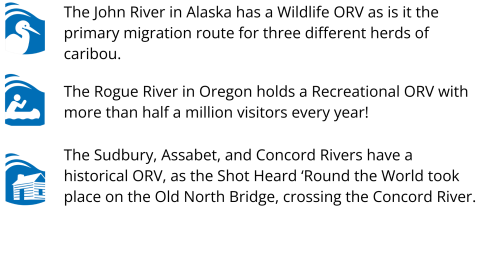It is important to note that although the Wild and Scenic Rivers Act (the Act) directs the process, designation is often very complex, and each river brings new elements to consider and factor into this pathway. With that, these steps can differ based on a number of factors. This is a general overview, and it is recommended to contact one of the lead agencies about a specific river.
There are two methods by which a river is designated. One method is straight forward, but because of the relatively rare set of circumstances that must first exist, it’s not often used. The other, most common path is, at its core, also straight forward, but there are any number of variations that might be involved. First, let’s look at the more common option.
Designating Rivers Through Congress
The far more common method of adding a river to the National System is through national legislation. Here, we explain the basics of the process.
Discussions With Lead Agency
One of the first questions considered is who owns the land along the river. The land ownership will determine which agency—Bureau of Land Management, National Park Service, U.S. Fish and Wildlife, or U.S. Forest Service—will take the lead in the wild and scenic river study and designation.
Wild and Scenic Study Requested
In most cases, a study of the river is conducted before designation to determine if the river is not only eligible, but also suitable for this program. The lead agency will conduct this study and report its findings to Congress.
The Wild and Scenic Rivers Act outlines three avenues through which studies are conducted:
- Section 5(a): This occurs when Congress authorizes a study to be conducted of a specific river. Often, a local organization will work with their congressional representatives to advocate for a study.
- Section 5(d)(1): The Wild and Scenic Rivers Act directs federal land management agencies to conduct 5(d)(1) studies as part of their normal planning processes, therefore Congressional approval is not required for this type of study. Many rivers that aren’t designated already have studies conducted.
- Section 2(a)(ii): After the governor(s) of a state(s) requests that a river be designated, the Secretary of the Interior instructs the National Park Service to study or evaluate the river and its associated resources to determine if 2(a)(ii) is the right path for designation.
Agency Conducts Study
The lead agency will determine if the rivers are eligible and suitable for designation based on a number of qualities.
Eligibility
In order for a river to be eligible for designation, it must adhere to two main requirements:
- Free Flowing: The rivers, or sections of rivers and tributaries must be free flowing, not just at the time of designation but with the stipulation that no further impediments will be made.
- Outstandingly Remarkable Values (ORVs): One of the goals of designation and management is to protect river values specific to that watershed. With this, designation requires the protection of an Outstandingly Remarkable Value (ORV), which is a river-related value that is rare, unique, or an exemplary feature at a regional or national scale. ORVs may include scenic, recreational, geologic, fish and wildlife, historic, cultural, or other similar values.
Suitability
In addition to determining eligibility, one of the purposes of the study is to determine if the river is also suitable for designation. These are important suitability questions that the study will investigate:
- Should the river’s values (free-flow, water quality, and ORVs) be protected or are there other conflicting river uses?
- Will the river’s values be protected through designation? Is it the best method for protecting the river corridor?
- Is there a demonstrated commitment to protect the river by any non-federal entities that may be partially responsible for implementing protective management?
Agency Provides Study Findings To Congress
After a study is conducted, the lead federal agency will transmit a study report with its findings to Congress. From there, Congress will deliberate and decide whether to designate the river. Often, a local organization will work with their congressional representatives to advocate for the designation.
Regardless of the outcome of an agency’s findings, Congress holds the authority to pass legislation that designates a river. There are numerous examples of rivers that have met the criteria for designation but have not led to introduced or passed bills designating those rivers into the National System. Alternatively, there have been cases where Congress has designated rivers without a study or before a study was conducted.
Congress Passes Designation Law
If Congress decides to designate a river as wild and scenic, it will pass a bill outlining the start and end points of designation, the mileage of this section, and which agency will administer the river.
River Is Designated
After designation, the lead agency, along with local organizations, if applicable, will implement a Comprehensive River Management Plan, focusing on the rivers’ resources and values.
Designating Rivers Through the Secretary of the Interior
Section 2(a)(ii) of the Wild & Scenic Rivers Act allows the Secretary of the Interior to designate a river if a state governor requests designation. However, for a river to qualify for the National System through Section 2(a)(ii) of the Act, four requirements must first be met.
- The river must first be designated as wild, scenic, or recreational (or the equivalent thereof) at the state level by, or pursuant to, an act of the legislature of that state. Usually, this means designation into a state program. However, there are very few states that have a state river protection system. There are examples where a river has first been protected at the state level without the benefit of a state rivers program (e.g., Middle Fork of the Vermilion), but this is less common.
- The river must meet eligibility criteria common to all national wild and scenic rivers, i.e., the river must be free-flowing, as determined by Section 16(b) of the Act and standards set by the Departments of the Interior and Agriculture, and possess one or more "outstandingly remarkable value" (ORV).
- The river must be administered by an agency or political subdivision of the state at no cost to the federal government, except for those lands already administered by an agency of the federal government.
- There must be effective mechanisms and regulations in place—local, state or federal—to provide for the long-term protection of those resources for which the river was deemed eligible.
There is another important element for designation under Section 2(a)(ii): You need a governor willing to request designation. For additional information, please see the paper entitled Designating Rivers Through Section 2(a)(ii) of the Wild & Scenic Rivers Act.




